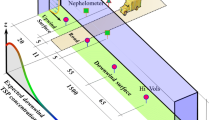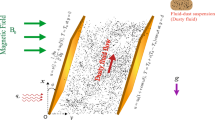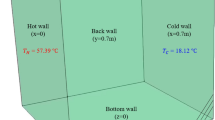Abstract
Lavatories are frequently used facilities, especially on long-haul flights. Flushing a vacuum toilet in a lavatory can induce strong airflow, produce aerosols in the toilet bowl, and resuspend deposited particles from the floor. However, the exact particle transport routes and the fates of particle after toilet flushing are unclear so far. This investigation used computational fluid dynamics (CFD) to model the transient airflow and pollutant transport after a toilet flushing process in a lavatory of a commercial aircraft. The time-varying pressure profile measured in a laboratory was assigned to the drainage valve as boundary conditions. The aerosols generated inside the toilet bowl during flushing and the particles resuspended from the lavatory floor were used as particle sources. Lagrangian tracking of airborne particles in the lavatory was conducted. In addition, ammonia gas was used to examine odor perception. The multi-physics software program COMSOL 5.4 was employed for numerical solution after being validated. The results revealed that more than 70% of the generated particles in the toilet bowl are drained into sewage. A few particles may leak out of the toilet bowl and remain suspended in the air for more than five minutes when the toilet lid is open during flushing. Flushing the toilet with a closed lid can effectively reduce the particle leakage and the spread of odor gas, but it leads to greater deposition of particles on both the lid and seat. There is a slight inhalation exposure risk in the initial three minutes after flushing with a closed lid.
Similar content being viewed by others
References
Abney SE, Bright KR, McKinney J, et al. (2021). Toilet hygiene-review and research needs. Journal of Applied Microbiology, 131: 2705–2714.
Amoah ID, Pillay L, Deepnarian N, et al. (2021). Detection of SARS-CoV-2 RNA on contact surfaces within shared sanitation facilities. International Journal of Hygiene and Environmental Health, 236: 113807.
Bae SH, Shin H, Koo HY, et al. (2020). Asymptomatic transmission of SARS-CoV-2 on evacuation flight. Emerging Infectious Diseases, 26: 2705–2708.
Bai Z, Dong Y, Wang Z, et al. (2006). Emission of ammonia from indoor concrete wall and assessment of human exposure. Environment International, 32: 303–311.
Barker J, Stevens D, Bloomfield SF (2001). Spread and prevention of some common viral infections in community facilities and domestic homes. Journal of Applied Microbiology, 91: 7–21.
Barker J, Jones MV (2005). The potential spread of infection caused by aerosol contamination of surfaces after flushing a domestic toilet. Journal of Applied Microbiology, 99: 339–347.
Best EL, Sandoe JAT, Wilcox MH (2012). Potential for aerosolization of Clostridium difficile after flushing toilets: The role of toilet lids in reducing environmental contamination risk. Journal of Hospital Infection, 80: 1–5.
Boor BE, Siegel JA, Novoselac A (2013). Wind tunnel study on aerodynamic particle resuspension from monolayer and multilayer deposits on linoleum flooring and galvanized sheet metal. Aerosol Science and Technology, 47: 848–857.
Chung SC, Lin Y, Yang C, et al. (2019). Natural ventilation effectiveness of awning windows in restrooms in K-12 public schools. Energies, 12: 2414.
Grün G, Trimmel M, Holm A (2012). Low humidity in the aircraft cabin environment and its impact on well-being—Results from a laboratory study. Building and Environment, 47: 23–31.
Hashemi S, Han M (2017). Control of urine odor in different sanitation practices and its implication on water saving. Journal of Water, Sanitation and Hygiene for Development, 7: 156–162.
Holmes JD, Simmons GC (2009). Gastrointestinal illness associated with a long-haul flight. Epidemiology and Infection, 137: 441–447.
Hsiang LP, Faeth GM (1995). Drop deformation and breakup due to shock wave and steady disturbances. International Journal of Multiphase Flow, 21: 545–560.
Johnson D, Lynch R, Marshall C, et al. (2013a). Aerosol generation by modern flush toilets. Aerosol Science and Technology, 47: 1047–1057.
Johnson DL, Mead KR, Lynch RA, et al. (2013b). Lifting the lid on toilet plume aerosol: A literature review with suggestions for future research. American Journal of Infection Control, 41: 254–258.
Jones DL, Baluja MQ, Graham DW, et al. (2020). Shedding of SARS-CoV-2 in feces and urine and its potential role in person-to-person transmission and the environment-based spread of COVID-19. The Science of the Total Environment, 749: 141364.
Joseph DD, Belanger J, Beavers GS (1999). Breakup of a liquid drop suddenly exposed to a high-speed airstream. International Journal of Multiphase Flow, 25: 1263–1303.
Kirking HL, Cortes J, Burrer S, et al. (2010). Likely transmission of norovirus on an airplane, October 2008. Clinical Infectious Diseases, 50: 1216–1221.
Lai ACK, Tan TF, Li WS, et al. (2018). Emission strength of airborne pathogens during toilet flushing. Indoor Air, 28: 73–79.
Li Z, Guan J, Yang X, et al. (2014). Source apportionment of airborne particles in commercial aircraft cabin environment: contributions from outside and inside of cabin. Atmospheric Environment, 89: 119–128.
Li X, Shang Y, Yan Y, et al. (2018). Modelling of evaporation of cough droplets in inhomogeneous humidity fields using the multi-component Eulerian-Lagrangian approach. Building and Environment, 128: 68–76.
Li P, Zhang T, Zhang Y (2022). Measuring the flushing-generated flow and aerosols in lavatory of commercial aircraft. Building and Environment, 214: 108948.
Lindgren T (2010). A case of indoor air pollution of ammonia emitted from concrete in a newly built office in Beijing. Building and Environment, 45: 596–600.
Liu Y, Ning Z, Chen Y, et al. (2020). Aerodynamic characteristics and RNA concentration of SARS-CoV-2 aerosol in Wuhan hospitals during COVID-19 outbreak. bioRxiv, https://doi.org/10.1101/2020.03.08.982637.
Mei X, Zhang T, Wang S (2016). Experimental investigation of jet-induced resuspension of indoor deposited particles. Aerosol Science and Technology, 50: 230–241.
Mui K, Wong L, Yu H, et al. (2017). Exhaust ventilation performance in residential washrooms for bioaerosol particle removal after water closet flushing. Building Services Engineering Research and Technology, 38: 32–46.
Rosati JA, Thornburg J, Rodes C (2008). Resuspension of particulate matter from carpet due to human activity. Aerosol Science and Technology, 42: 472–482.
Sato H, Hirose T, Kimura T, et al. (2001). Analysis of malodorous volatile substances of human waste: feces and urine. Journal of Health Science, 47: 483–490.
Schreck JH, Lashaki MJ, Hashemi J, et al. (2021). Aerosol generation in public restrooms. Physics of Fluids, 33: 033320.
Sinha K, Yadav MS, Verma U, et al. (2021). Effect of recirculation zones on the ventilation of a public washroom. Physics of Fluids, 33: 117101.
Tung YC, Hu SC, Tsai TY (2009). Influence of bathroom ventilation rates and toilet location on odor removal. Building and Environment, 44: 1810–1817.
Verani M, Bigazzi R, Carducci A (2014). Viral contamination of aerosol and surfaces through toilet use in health care and other settings. American Journal of Infection Control, 42: 758–762.
Wei J, Li Y (2015). Enhanced spread of expiratory droplets by turbulence in a cough jet. Building and Environment, 93: 86–96.
Widdowson MA, Glass R, Monroe S, et al. (2005). Probable transmission of norovirus on an airplane. JAMA, 293: 1859–1860.
Wu T, Fu M, Valkonen M, et al. (2021). Particle resuspension dynamics in the infant near-floor microenvironment. Environmental Science and Technology, 55: 1864–1875.
Yang C, Yang X, Xu T, et al. (2009). Optimization of bathroom ventilation design for an ISO Class 5 clean ward. Building Simulation, 2: 133–142.
Zhang Z, Zeng L, Shi H, et al. (2021). Dynamics and numerical simulation of contaminant diffusion for a non-flushing ecological toilet. Energies, 14: 7570.
Acknowledgements
This work was partially supported by the National Natural Science Foundation of China (Grant No. 52111530186) and Stiftelsen för internationalisering av högre utbildning och forskning (STINT), Sweden (Dnr: CH2020-8665).
Author information
Authors and Affiliations
Contributions
Pin Li conducted the modeling, analyzed the data and wrote the first draft of the manuscript. Wei Liu discussed the research and edited the writing. Tengfei (Tim) Zhang designed the research, supervised the work and edited the writing. All authors reviewed the manuscript.
Corresponding author
Ethics declarations
The authors have no competing interests to declare that are relevant to the content of this article.
Rights and permissions
About this article
Cite this article
Li, P., Liu, W. & Zhang, T.T. CFD modeling of dynamic airflow and particle transmission in an aircraft lavatory. Build. Simul. 16, 1375–1390 (2023). https://doi.org/10.1007/s12273-023-1031-3
Received:
Revised:
Accepted:
Published:
Issue Date:
DOI: https://doi.org/10.1007/s12273-023-1031-3




